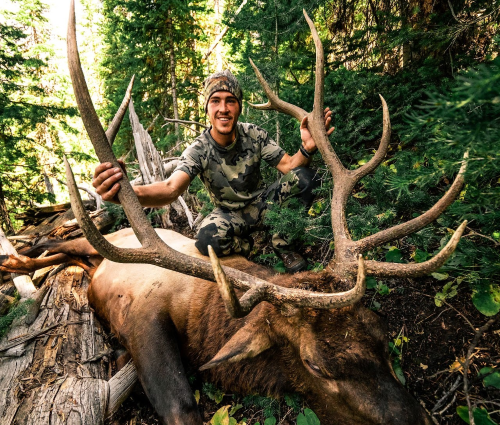FISH CATCHING TRAVEL
How to Fish Croaker –
Everything You Need to Know to Get Started
by Chad “The Mad Trout Fisherman” McCrory
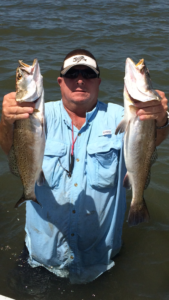
With croaker fishing, first lets start with the rod and reel. I use a 7ft bait casting rod 1/4 to 3/4 ounce. I use a baitcasting reel in a 150/ 200 series with the only difference being spool capacity. With spinning gear I use the same 7 ft med/ heavy which allows me to get the maximum possibly distance out of my cast.
Now lets go to the line, first thing i want to say about that is, if it ain’t broke don’t fix it. I use 12lb Big Game green. While many people have gone to no stretch braid I refuse. When throwing croaker with a baitcaster, if you throw one off it could mean disaster with a big backlash if you are not quick enough to stop the spool. Mono is not so bad when that happens, but braid can be a nightmare. Though I’m good at getting out backlashes, and have had plenty of experience, that braid backlash often makes them it knife cutter. So I am a mono guy.
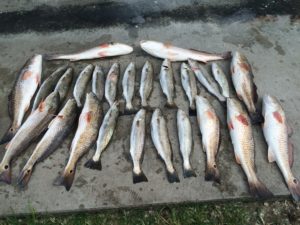
Not croaker fishing? You are missing out!
Now the leader line is a 20, 30, or 40# attached to a swivel. I generally use about 18″-24″ of leader. When croaker season starts the croaker are small so I use a 4/0 on a 20lb leader and freeline them, which usually starts in mid May to early June. Then as the croaker get bigger I go to 5/0 and 30lb. Finally to the 6/0 and 40lb leader with the bigger baits. Simple, bigger baits = bigger hooks and leader. Usually by mid July the croaker are strong swimmers so I add a croaker clicker. This does two things, first it adds noise to the bait. Second it also sinks the croaker quickly, keeping it away from those liar birds, which can be a real pain in clear water due their ability to dive so deep to get your bait. The clicker (noise attractant) I prefer is a piece of wire with brass and glass beads on it. It seems to cast better and produces more fish for me.
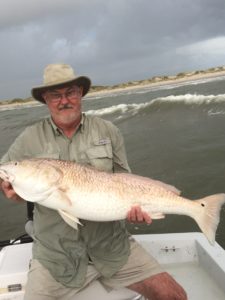
Redfish Candy.
A bait stand is a bait stand if they have croaker, right? Wrong! I have learned over the years that fresh live croaker are considerably better than croaker that are weak and full of tank sores. (Implication – buy from a busy bait stand.) Here is another tip, croaker are naturally slimy and that is how you want them. When transporting your croaker in the live well an oxygen set up is best, with second best being a Mr Bubbles or air that comes through an aeration stone. Aerators that blast re-circulating water do two things. First, they wash all the slime off your croaker, and second, they will heat the water in your livewell, making the croaker weak and unnatural. Fish won’t eat something they think may make them sick. So the well being of your bait is very important.
Now with that out of the way, lets talk about presentation and hook placement in the croaker. The surf is the easiest of them all when conditions are right. Meaning, when you can anchor in the third gut and are in no danger of waves breaking over the bow. That anchor placement allows you to throw your bait in both the second and first gut. (Obviously a weight is necessary, and is determined by what is necessary due to current and tides to keep your bait stable.)
I like to keep my rod at a 45 degree angle which allows me to feel the thump and then feed the fish line without releasing my thumb bar. When the rod gets parallel to the water I set the hook hard. Like you do when worm fishing for bass.
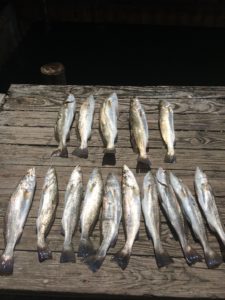
Are you getting the picture yet?
As for the bay, I fish croaker a little differently, especially in grassy areas. I throw it out, let it sink, and jig it back up to the top of the water column, all the time waiting on the thump. As soon as I feel it, I immediately push my thumb bar allowing the fish to run for a bit, then locking him in and setting the hook. Some days when you feel the thump they will run straight towards you, often like the bite bass fishing Texas rigged worms.
Most of the time hook placement in the croaker is right above the mid line in between the dorsal fin and tail. However, when looking for fish on a flat I will hook them underneath the bottom lip, coming out right below the nose. This does a couple of things, it allows me to get many cast out of a croaker without throwing him off, and it gives the croaker a more natural look as I slowly reel him in across sand pockets and guts. It is the most effective locator technique I use. It also works well when the trout, instead of eating your croaker, just want to kill it.
Hope I have helped a few folks out.
Good Luck and Tight Lines
(Chad is an experienced all-around fisherman. He is highly successful wading and fishing croaker for big strings of speckled trout and redfish on the Texas Coast. We are fortunate that he has taken the time to share his knowledge with us. There is much here to digest, but for those of you like me who are learning, or wanting to learn to croaker fish, this is all you need to know to get started. There is a wealth of knowledge in his words. So a big thanks to Chad.)

